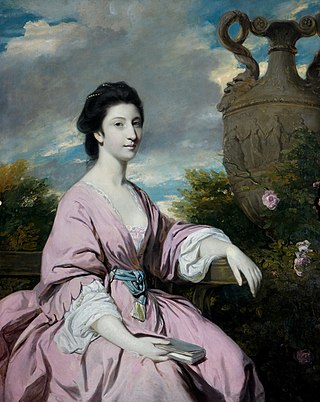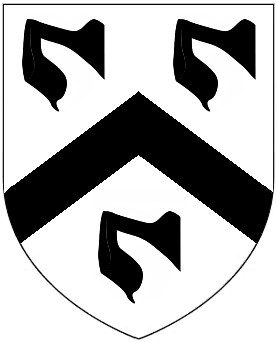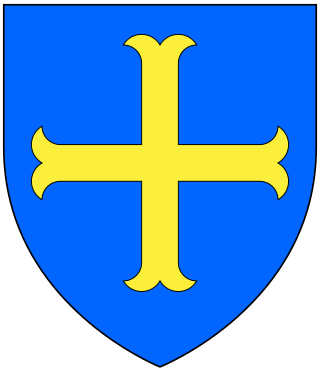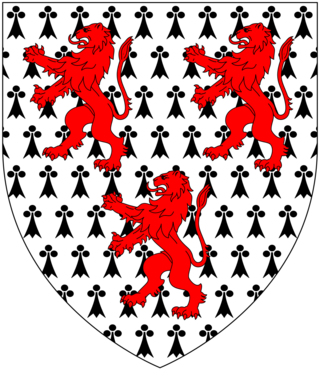
Marquess of Aberdeen and Temair, in the County of Aberdeen, in the County of Meath and in the County of Argyll, is a title in the Peerage of the United Kingdom. It was created on 4 January 1916 for John Hamilton-Gordon, 7th Earl of Aberdeen.

Viscount Cobham is a title in the Peerage of Great Britain that was created in 1718. Owing to its special remainder, the title has passed through several families. Since 1889, it has been held by members of the Lyttelton family.

Earl of Cottenham, of Cottenham in the County of Cambridge, is a title in the Peerage of the United Kingdom. It was created in 1850 for the prominent lawyer and Whig politician Charles Pepys, 1st Baron Cottenham. ) He served as Lord Chancellor from 1836 to 1841 and from 1846 to 1850. Pepys had already been created Baron Cottenham, of Cottenham in the County of Cambridge, in 1836, and was made Viscount Crowhurst, of Crowhurst in the County of Surrey, at the same time he was given the earldom. These titles are also in the Peerage of the United Kingdom. The viscountcy is used as a courtesy title for the Earl's eldest son and heir apparent.

Viscount Gage, of Castle Island in the County of Kerry of the Kingdom of Ireland, is a title in the Peerage of Ireland. It was created in 1720 for Thomas Gage, along with the subsidiary title of Baron Gage, of Castlebar in the County of Mayo, also in the Peerage of Ireland. In 1744 he also succeeded his cousin as eighth Baronet, of Firle Place. The titles remain united. The Gage family descends from John Gage, who was created a baronet, of Firle Place in the County of Sussex, in the Baronetage of England on 26 March 1622. His great-grandson, the seventh Baronet, represented Seaford in Parliament. He was succeeded by his first cousin, Thomas Gage, 1st Viscount Gage, the eighth Baronet. He sat as a Member of Parliament for Minehead and Tewkesbury and also served as Governor of Barbados. In 1720, 24 years before succeeding in the baronetcy, he was raised to the Peerage of Ireland as Baron Gage and Viscount Gage. His second son was the military commander the Hon. Thomas Gage.
Baron Athlumney, of Somerville and Dollarstown in the County of Meath, was a title in the Peerage of Ireland. It was created in 1863 for the Liberal politician Sir William Meredyth Somerville, 5th Baronet, who had previously served as Chief Secretary for Ireland. In 1866 he was also created Baron Meredyth, of Dollardstown in the County of Meath, in the Peerage of the United Kingdom. He was succeeded by his eldest and only surviving son from his second marriage, the second Baron. He was childless and on his death in 1929 the baronies became extinct while the baronetcy became dormant.

Viscount Maynard, of Easton Lodge in the County of Essex, was a title in the Peerage of Great Britain. It was created in 1766 for Charles Maynard, 6th Baron Maynard, Lord-Lieutenant of Suffolk. He was made Baron Maynard, of Much Easton in the County of Essex, at the same time, also in the Peerage of Great Britain. Both titles were created with special remainder, failing male issue of his own, to his kinsman Sir William Maynard, 4th Baronet. The 1st Viscount was unmarried and on his death in 1775 the baronetcy of Easton Parva, the Irish barony of Maynard created in 1620 and the English barony of Maynard created in 1628 became extinct. He was succeeded in the barony of 1766 and the viscountcy according to the special remainder by his kinsman Sir Charles Maynard, 5th Baronet, who became the 2nd Viscount. The latter was succeeded by his nephew, the 3rd Viscount, who served as Lord-Lieutenant of Essex. He had no surviving male issue and on his death in 1865 the baronetcy, barony and viscountcy became extinct. His granddaughter, Daisy Maynard, daughter of Colonel Charles Henry Maynard and future wife of Francis Greville, 5th Earl of Warwick, succeeded to most of the Maynard estates.

Baron Muncaster was a title in the Peerage of Ireland and in the Peerage of the United Kingdom held by the Pennington family. This family, of Muncaster Castle in Cumberland, descended from William Pennington, who was created a Baronet, of Muncaster in the County of Cumberland, in the Baronetage of England in 1676. He was succeeded by his son, the second Baronet. He represented Cumberland in the House of Commons. His son, the third Baronet, also sat as Member of Parliament for this constituency. He died childless and was succeeded by his younger brother, the fourth Baronet. On his death the title passed to his son, the fifth Baronet. He was Member of Parliament for Milborne Port and Colchester. In 1783, ten years before he succeeded his father in the baronetcy, he was raised to the Peerage of Ireland as Baron Muncaster, with remainder in default of male issue of his own to his younger brother Lowther Pennington and the heirs male of his body.
There have been six baronetcies created for persons with the surname Newton, three in the Baronetage of England, one in the Baronetage of Nova Scotia and two in the Baronetage of the United Kingdom.
There have been five baronetcies created for persons with the surname Ward, one in the Baronetage of England, one in the Baronetage of Ireland and three in the Baronetage of the United Kingdom. See also Warde baronets.
There have been seven baronetcies created for persons with the surname Powell, five in the Baronetage of England and two in the Baronetage of the United Kingdom. Only one creation is extant as of 2007.

Theodosia Hawkins-Magill, later Countess of Clanwilliam, was a great heiress and landowner in County Down, Ireland.
There have been three baronetcies created for persons with the surname Osborne, two in the baronetage of England and one in the baronetage of Ireland. Two creations are extant.

There have been three baronetcies, all in the Baronetage of England, created for members of the Mansel family, which played a major role in the early re-settlement of the Gower Peninsula, in Glamorgan, Wales. Only one creation is extant as of 2008.

There have been three baronetcies created for descendants of the ancient Norman family of Molyneux who were granted extensive estates in Lancashire after the Norman Conquest.

The Hannay Baronetcy, of Mochrum in the Stewardry of Kirkcudbright, was a title in the Baronetage of Nova Scotia. It was created on 31 March 1630 for Robert Hannay. The title became dormant on the death of the second Baronet in 1689. The title was claimed in 1783 by Samuel Hannay, the third Baronet. He sat as Member of Parliament for Camelford. His son, the fourth Baronet, was in the service of the Emperor of Austria. He was unmarried and the baronetcy again became dormant on his death in 1842.

The Chudleigh Baronetcy, of Ashton in the County of Devon, was a title in the Baronetage of England. It was created on 1 August 1622 for George Chudleigh (d.1656), Member of Parliament for St Michael's, East Looe, Lostwithiel and Tiverton. The title became extinct on the death of the sixth Baronet in 1745.
There have been three baronetcies created for persons with the surname Humble, two in the Baronetage of England and one in the Baronetage of the United Kingdom. All are extinct.
Sir Redmond Everard, 4th Baronet was an Irish Jacobite baronet and politician.
Sir John Dongan, 2nd Baronet (1603–1650) was a member of the Irish Parliament.

Sir Alexander Macdonald, 7th Baronet, 14th Chief of Sleat was a Scottish Chief of Clan Macdonald of Sleat.











